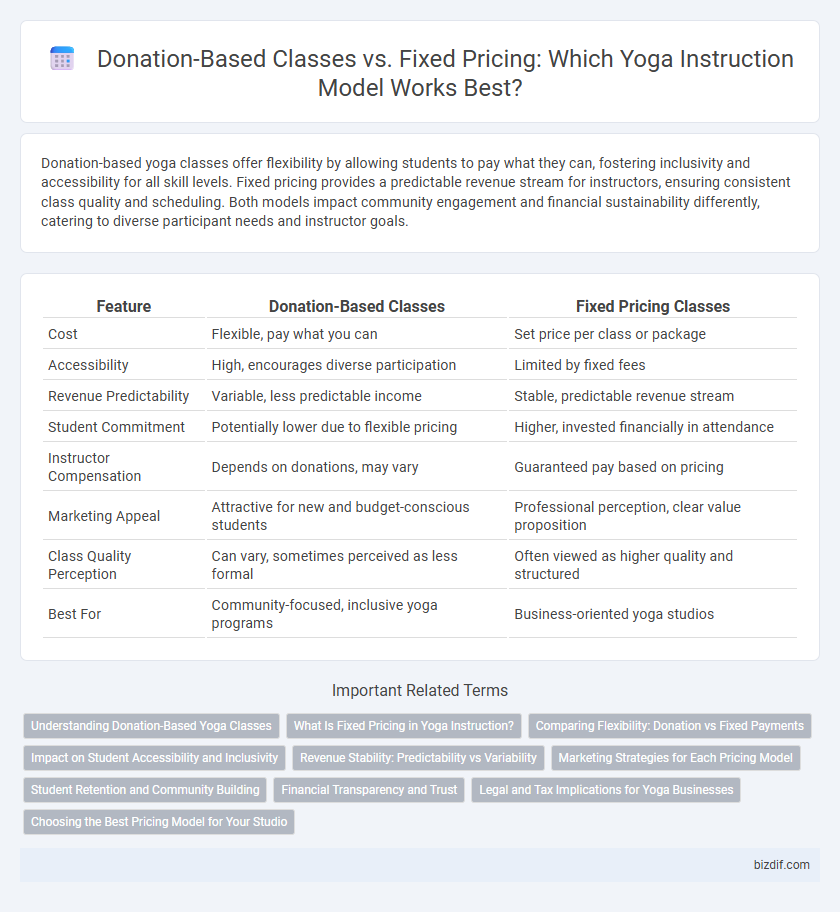Donation-based yoga classes offer flexibility by allowing students to pay what they can, fostering inclusivity and accessibility for all skill levels. Fixed pricing provides a predictable revenue stream for instructors, ensuring consistent class quality and scheduling. Both models impact community engagement and financial sustainability differently, catering to diverse participant needs and instructor goals.
Table of Comparison
| Feature | Donation-Based Classes | Fixed Pricing Classes |
|---|---|---|
| Cost | Flexible, pay what you can | Set price per class or package |
| Accessibility | High, encourages diverse participation | Limited by fixed fees |
| Revenue Predictability | Variable, less predictable income | Stable, predictable revenue stream |
| Student Commitment | Potentially lower due to flexible pricing | Higher, invested financially in attendance |
| Instructor Compensation | Depends on donations, may vary | Guaranteed pay based on pricing |
| Marketing Appeal | Attractive for new and budget-conscious students | Professional perception, clear value proposition |
| Class Quality Perception | Can vary, sometimes perceived as less formal | Often viewed as higher quality and structured |
| Best For | Community-focused, inclusive yoga programs | Business-oriented yoga studios |
Understanding Donation-Based Yoga Classes
Donation-based yoga classes offer flexible pricing, allowing students to pay what they can afford or feel the class is worth, fostering inclusivity and community support. This model removes financial barriers, making yoga accessible to a wider audience and encouraging consistent practice without the pressure of fixed fees. Understanding donation-based yoga helps both instructors and practitioners create a supportive environment centered on generosity and mutual respect.
What Is Fixed Pricing in Yoga Instruction?
Fixed pricing in yoga instruction refers to a set, predetermined fee charged for each class or a series of sessions, providing students with clear expectations and consistent revenue for instructors. This model simplifies budgeting for practitioners by eliminating uncertainty, while instructors benefit from stable income and easier financial planning. Fixed pricing often includes packages or memberships that encourage commitment and regular attendance, enhancing the overall client experience.
Comparing Flexibility: Donation vs Fixed Payments
Donation-based yoga classes offer unparalleled flexibility by allowing participants to contribute amounts that fit their financial situation, fostering inclusivity and accessibility for all income levels. Fixed pricing ensures consistent revenue for instructors and facilitates predictable budgeting for students but may deter those with limited funds from regular attendance. Evaluating these payment structures highlights how donation models promote adaptable participation, while fixed fees provide financial stability for sustained class offerings.
Impact on Student Accessibility and Inclusivity
Donation-based yoga classes significantly enhance student accessibility by removing financial barriers and encouraging diverse participation regardless of economic background. Fixed pricing models may restrict access for lower-income individuals, limiting inclusivity within the yoga community. Offering donation-based options promotes a more equitable environment, fostering broader engagement and supporting students from varied socioeconomic statuses.
Revenue Stability: Predictability vs Variability
Donation-based yoga classes often lead to revenue variability due to fluctuating attendee contributions, making financial planning less predictable for instructors. Fixed pricing models provide revenue stability through consistent payments, allowing for more accurate budget forecasting and business growth strategies. Balancing these approaches depends on an instructor's priority between community accessibility and steady income.
Marketing Strategies for Each Pricing Model
Donation-based yoga classes leverage community engagement and social proof as key marketing strategies, encouraging word-of-mouth promotion and fostering a sense of inclusivity that attracts diverse participants. Marketing for fixed pricing classes often emphasizes value proposition, consistency, and premium experience through targeted digital campaigns, loyalty programs, and clear pricing benefits to sustain steady revenue. Both models benefit from leveraging social media platforms and local partnerships, but donation-based models focus more on emotional appeal while fixed pricing relies on transactional clarity and perceived quality.
Student Retention and Community Building
Donation-based yoga classes foster greater student retention by creating an inclusive atmosphere where financial barriers are minimized, encouraging regular attendance and deeper community connections. Fixed pricing offers predictable revenue but may limit accessibility, reducing overall class size and engagement. Emphasizing donation-based models enhances long-term community building, as students feel more invested and valued beyond monetary commitments.
Financial Transparency and Trust
Donation-based yoga classes foster financial transparency by allowing participants to contribute amounts that reflect their personal circumstances, which builds trust through openness and inclusivity. Fixed pricing offers predictable revenue streams for instructors but may create barriers for students with limited budgets, potentially undermining trust among those seeking equitable access. Clear communication about payment policies and the purpose of collected funds is essential to enhance trust regardless of the chosen pricing model.
Legal and Tax Implications for Yoga Businesses
Yoga businesses choosing donation-based classes face complex legal and tax implications, including challenges in predicting revenue and complying with local regulations on charitable contributions. Fixed pricing models provide clearer income documentation, facilitating tax reporting and simplifying the application of sales tax or VAT where required. Understanding state-specific laws governing service-based businesses and properly categorizing income is essential to avoid audits and penalties.
Choosing the Best Pricing Model for Your Studio
Donation-based yoga classes foster inclusivity and community engagement by allowing participants to pay what they can, increasing class accessibility and encouraging regular attendance. Fixed pricing offers predictable revenue streams and simplifies financial planning for studio owners while establishing clear value for services rendered. Evaluating your target demographic, financial goals, and local market trends helps determine the optimal pricing strategy that balances sustainability with client satisfaction.
Donation-based classes vs Fixed pricing Infographic

 bizdif.com
bizdif.com